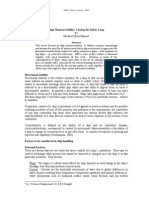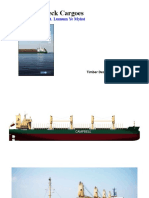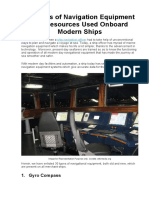Mooring Topics
Mooring Topics
Uploaded by
joeven64Copyright:
Available Formats
Mooring Topics
Mooring Topics
Uploaded by
joeven64Original Description:
Copyright
Available Formats
Share this document
Did you find this document useful?
Is this content inappropriate?
Copyright:
Available Formats
Mooring Topics
Mooring Topics
Uploaded by
joeven64Copyright:
Available Formats
EXTRACT FROM
NAVAL SHIPS TECHNICAL MANUAL
CHAPTER 582 MOORING AND TOWING (S9086-TW-STM-010/CH-582R2
REVISION 2)
582-1.1.3 PURPOSE OF MOORING. The purpose of a mooring is to safely hold a ship in a berth or in a certain position to accomplish a specific mission. Ship moorings are provided for: a. Loading/Unloading Loading and unloading items such as stores, cargo, personnel, ammunition, etc. b. Maintenance/Repairs Scheduled maintenance and simple repairs can be performed at sea. Certain actions require shore services, special parts, and outside assistance that can only be provided while moored. c. Mission Moorings are used to support special mission requirements, such as surveillance, tracking, training, salvage, etc. d. Ship Storage Ships in an inactive or reserve status are stored at moorings. This reduces costs to simple upkeep while ensuring the ship can be made available again if needed. SHIPBOARD MOORING EQUIPMENT. The majority of mooring systems aboard ships are relatively simple consisting of, the mooring lines, a few accessories and deck fittings, and two speed capstans. Ships do not normally carry the fenders to which they may moor against. Larger ships may have variable speed capstans for improved line handling capability and/or constant tension mooring machinery for ease of tending mooring lines. 582-1.2.5.1 Mooring Lines and Accessories. Mooring lines are used to secure a ship to a wharf, pier, dock or another ship. The size and strength of mooring lines is matched to the ship and generally increases as the size of the ship increases. Mooring lines of nylon or polyester have most often been used. Lines made of high strength, low stretch, and reduced snapback aramid fibers are also approved and are becoming more widely used because of their inherent safety characteristics. Mooring line accessories include tattletales, line throwing devices, rat guards, and fairleaders. Detailed information on mooring lines is discussed in Section 4 of this NSTM. 582-1.2.5.2 Mooring Fittings. Mooring fittings include chocks, bitts, cleats, and hawser reels. Detailed information on shipboard mooring fittings and accessories is provided in Section 5 of this NSTM. 582-1.2.5.3 Mooring Machinery. Mooring machinery facilitates the handling and securing of mooring lines. It includes the capstan head and related machinery, as well as constant tension mooring winches. Detailed coverage of mooring machinery is provided in Section 6 of this NSTM.
582-1.3 BERTHING FACILITIES 582-1.3.1 STRUCTURES. The typical pier or wharf includes several key elements for ship mooring, including mooring fittings, fenders, brow and shore services. Figure 582-1-1 shows a typical berth. In some cases camels are provided for additional standoff. All of these items must be in good condition and properly used to help ensure safe mooring. 582-2.2.3 BERTHING A SHIP. Berthing is defined as the process of bringing a ship in to a moored configuration. There are two basic ways of berthing a ship: assisted or unassisted. Assisted berthing usually involves tugboats. In an unassisted berthing, the ship uses its own resources only. 582-2.2.3.1 Assisted Berthing/Ship Maneuvering with Tugboats. Tugboats can be used to assist in the docking of a ship. Essentially tugs either push or pull the ship, to help guide or position it. Tugs also use tow lines to help maneuver ships to and from berths. They push a ship into a berth, or move it away from a berth by moving between the dock and the ships hull and pushing it away from the dock. When tugs are holding a ship against a pier, do not over-tighten the initial mooring lines. Depending on how the tugs move away, the lines may become overloaded and break. Short aft mooring lines on combatant ships are particularly susceptible to this possibility. 582-2.2.3.2 Unassisted Berthing. Great care must be taken when berthing a ship without assistance. The ship is exposed to a combination of wind and current that imposes a force on the hull which must be overcome by the capstans and mooring lines to warp the ship to pier. Twin or multiple screw ships have better maneuverability for unassisted berthing. It is more difficult for a single screw ship to berth unassisted. A few unassisted berthing procedures are given below. 582-2.4.2 SAFETY PRECAUTIONS. When using synthetic fiber lines, there are certain safety precautions that must be observed. Consult NSTM Chapter 613, Wire and Fiber Rope and Rigging, for a complete listing of precautions to be observed when handling synthetic fiber ropes. Some of the more important safety precautions are: WARNING Ropes may surge suddenly causing injury to line handlers. Non-aramid synthetic ropes stretch under load, recover rapidly, and have a low coefficient of friction. a. Exercise extreme care when easing out or checking synthetic lines under heavy load from around bitts, cleats, and other holding devices. To maintain control when checking lines, take no more than two round turns on a cleat or bitt, as recommended in NSTM Chapter 613, Wire and Fiber Rope and Rigging. When checking a synthetic line under heavy load, take two round turns followed by no more than two figure eight bends; figure eight bends tend to lock up and surge unexpectedly. The use of figure eight bends in checking a line under heavy load will present a danger to personnel and cause extreme difficulty in handling lines. b. Figure eight bends can cause problems especially when used on synthetic fiber ropes. With these ropes, the figure eight bends lock up under heavy loads (primarily on the loaded side). As the rope on the loaded side elongates, its diameter decreases and the rope comprising the figure eight bend(s) slips suddenly. The rope then surges so rapidly that it can ride over the top of the bitts.
WARNING Post safety observers to ensure that line handlers stand a minimum of 6 feet from bitts under load. This is particularly important in mooring operations. c. Nylon rope stretches to nearly one and one half times its original length prior to parting. Upon parting, it instantaneously returns to its original length causing the broken ends to snap back with hazardous force. In view of this danger, it is imperative that no one stands in the direct line of pull when heavy loads are applied on the line. Polyester rope stretches to nearly one and one third times its original length before parting and is equally dangerous. Aramid rope stretches about six percent over its original length. Nevertheless the risk of injury from a parting aramid rope snapping back should not be overlooked. Table 582-2-4 shows the approximate elongation of nylon and polyester ropes at breaking. These elongation percentages were taken from the military specifications and commercial item descriptions for the ropes. To educate the ships crew, specially S9086-TW-STM-010/CH-582R2 582-18 line handlers, about synthetic line snapback, the Navy has prepared a video training tape called Synthetic Line Snapback , Order No. 82971DN, 1982. See paragraph 582-1.4.3 for ordering information. d. Four strand aramid rope is designed to fail sequentially, meaning that one of the four strands will fail before the other strands. However, this has only been demonstrated on 50-foot test lengths. Regardless of the length of rope out when under tension, this rope should be treated with the same respect afforded other synthetic mooring lines made of nylon or polyester.
You might also like
- Navigation Lights Flashcards PDFDocument22 pagesNavigation Lights Flashcards PDFjoeven64100% (2)
- Type A & B Ship Question & AnswerDocument5 pagesType A & B Ship Question & Answerjoeven6433% (3)
- International Code of SignalsDocument1 pageInternational Code of Signalsjoeven64100% (1)
- Introduction To Ice Navigation PDFDocument24 pagesIntroduction To Ice Navigation PDFMarijaŽaper100% (2)
- OCIMF PublicationsDocument2 pagesOCIMF PublicationsAnonymous qKz3IEa6d786% (7)
- Library Books AmendedDocument4 pagesLibrary Books Amendedbittu692No ratings yet
- Aerials & Radio Frequency PropagationDocument30 pagesAerials & Radio Frequency Propagationjoeven64No ratings yet
- Celestial Navigation FormulasDocument8 pagesCelestial Navigation Formulasjoeven64100% (1)
- Who MC Local AnaesthesiaDocument190 pagesWho MC Local AnaesthesiaKevin Ruiz CortesNo ratings yet
- Ship ConstructionDocument645 pagesShip Construction8408 :Rohan NaikwadiNo ratings yet
- Navigation 01Document8 pagesNavigation 01Khian LiNo ratings yet
- MGN 0018 - Dangers of InteractionDocument4 pagesMGN 0018 - Dangers of InteractiontonyNo ratings yet
- Parametric RollDocument3 pagesParametric RollDnv BaileyNo ratings yet
- Ship Manoeuvring-Closing The Safety LoopDocument13 pagesShip Manoeuvring-Closing The Safety LoopMichael ManuelNo ratings yet
- Annex 13 - Magnetic CompassesDocument4 pagesAnnex 13 - Magnetic CompassesTraci MorganNo ratings yet
- Deck CargoDocument29 pagesDeck CargoKaede xNo ratings yet
- Deck Ref LibraryDocument25 pagesDeck Ref LibrarycptmehmetkaptanNo ratings yet
- Liquefied Petroleum Gas Tanker (LPG) Cargo OperationDocument5 pagesLiquefied Petroleum Gas Tanker (LPG) Cargo Operationnazrulfreelancer1989100% (1)
- Ships NomenclatureDocument27 pagesShips NomenclatureKevin A. Yambao100% (1)
- Ship ManeuveringDocument10 pagesShip ManeuveringnfournarNo ratings yet
- Deck Watchkeeping I: STCW Code Table A-II/ 1Document209 pagesDeck Watchkeeping I: STCW Code Table A-II/ 1Cenen Archie HueraNo ratings yet
- Effect of Free Surface & Six Degree FreedomDocument4 pagesEffect of Free Surface & Six Degree FreedomHOSSAIN AL FAYSALNo ratings yet
- Bridge Resource ManagementDocument5 pagesBridge Resource ManagementBerbaño, Jan JoshuaNo ratings yet
- Special Considerations For Container ShipsDocument8 pagesSpecial Considerations For Container ShipsInsan AhammadNo ratings yet
- Lashing and Securing FOR A Ship Carring Timber Deck CargoDocument7 pagesLashing and Securing FOR A Ship Carring Timber Deck CargoBeeKay RaurNo ratings yet
- D26-Seam2 - 5 3 05Document5 pagesD26-Seam2 - 5 3 05joeven64No ratings yet
- Practical Assessment 3 RiggingsDocument4 pagesPractical Assessment 3 RiggingsDzenrhe Paran100% (2)
- !!! Best Practice Snapback ZonesDocument2 pages!!! Best Practice Snapback ZonesUser100% (1)
- What Seafarers Should Do After The Vessel Receives Storm WarningDocument2 pagesWhat Seafarers Should Do After The Vessel Receives Storm WarningCyrus Bumalo100% (1)
- Muster ListDocument6 pagesMuster ListSachin DubeyNo ratings yet
- Intact Stability CriteriaDocument4 pagesIntact Stability CriteriaAmit TomerNo ratings yet
- Nautical TermsDocument7 pagesNautical Termsanagpal2009No ratings yet
- 2012 Manned Models OverviewDocument45 pages2012 Manned Models OverviewAhmad Imran100% (1)
- NMD-Guidelines On The Implementation of Specific Measures To Ensure A Sufficient Safety Level During Anchor Handling (AH) Operations Carried Out by Supply Ships or TugsDocument5 pagesNMD-Guidelines On The Implementation of Specific Measures To Ensure A Sufficient Safety Level During Anchor Handling (AH) Operations Carried Out by Supply Ships or Tugsronny-suNo ratings yet
- 919 Damage Control PlansDocument5 pages919 Damage Control PlanssabaingiNo ratings yet
- Decision Making System For The Collision Avoidance of Marine Vessel Navigation Based On COLREGs Rules and RegulationsDocument8 pagesDecision Making System For The Collision Avoidance of Marine Vessel Navigation Based On COLREGs Rules and RegulationsLP Perera100% (1)
- Safety Management Manual: Checklist For Passage PlanningDocument2 pagesSafety Management Manual: Checklist For Passage PlanningAvesh Alam100% (1)
- Aastmt: Ali Abd Alrahman 1 8 2 0 0 5 3 3 Term 4 Ship HandlingDocument3 pagesAastmt: Ali Abd Alrahman 1 8 2 0 0 5 3 3 Term 4 Ship Handlingعلي عبد الرحمن الزيديNo ratings yet
- General Ship KnowledgeDocument7 pagesGeneral Ship KnowledgeFarhan IrshadNo ratings yet
- Memory Aid For Rule 18 - 22 COLREGDocument2 pagesMemory Aid For Rule 18 - 22 COLREGafifrhmxNo ratings yet
- Lashing and DunnageDocument4 pagesLashing and DunnageClark FranciscoNo ratings yet
- Explain With The Help of Suitable Diagram, The Sequential Formation of Sea IceDocument6 pagesExplain With The Help of Suitable Diagram, The Sequential Formation of Sea IceRagunath Ramasamy100% (1)
- Appendix1 Syllabus Amsa Oral Exam Cert Competency Master Chief Mate 3000gtDocument4 pagesAppendix1 Syllabus Amsa Oral Exam Cert Competency Master Chief Mate 3000gtAadiraj SinghNo ratings yet
- Unit 1 - Ships Magnetism Part 1Document13 pagesUnit 1 - Ships Magnetism Part 1The SinghNo ratings yet
- OOW Reading ListDocument1 pageOOW Reading ListLovepreet Shah100% (1)
- 13 Timber Deck Cargoes (II)Document24 pages13 Timber Deck Cargoes (II)Kyaw Zin LynnNo ratings yet
- What Is Navigation?: Its Taking The Ship From One Berth To Another BerthDocument36 pagesWhat Is Navigation?: Its Taking The Ship From One Berth To Another BerthAboody AL-ghamdyNo ratings yet
- Imo - Survey Guidelines Under The Harmonized System of Survey and Certification (HSSC) 2019Document222 pagesImo - Survey Guidelines Under The Harmonized System of Survey and Certification (HSSC) 2019s0606No ratings yet
- BEQ Consolidated PDFDocument117 pagesBEQ Consolidated PDFShiv RanjanNo ratings yet
- Australian Maritime College Capt. Darrel SilvaDocument32 pagesAustralian Maritime College Capt. Darrel SilvadarrelsilvaNo ratings yet
- Ice Navigation SimulatorDocument41 pagesIce Navigation SimulatornnshghNo ratings yet
- Container Cargo NotesDocument8 pagesContainer Cargo NotesdhaneshbhorNo ratings yet
- Bridge Watchkeeping MMD QuestionsDocument1 pageBridge Watchkeeping MMD Questionspramod_kbNo ratings yet
- Advanement Exam Review SheetDocument4 pagesAdvanement Exam Review SheetPamela EtienneNo ratings yet
- Parametric Rolling - Container Lashing Systems: March 2002Document1 pageParametric Rolling - Container Lashing Systems: March 2002Dee CeeNo ratings yet
- Sqa Nav Theory 2015 To 2019 UpdatedDocument196 pagesSqa Nav Theory 2015 To 2019 Updatedvijay bhatiaNo ratings yet
- MSC Circ.456 Stabilty CriteriaDocument22 pagesMSC Circ.456 Stabilty Criteriapuddisaali100% (1)
- Stability Sqa Oow Wed - 8 February 2017Document6 pagesStability Sqa Oow Wed - 8 February 2017Stelios TheodorouNo ratings yet
- Course Specs Nav II CHEDDocument5 pagesCourse Specs Nav II CHEDReymarr HijaraNo ratings yet
- Describe and Illustrate Standard Steel SectionsDocument11 pagesDescribe and Illustrate Standard Steel SectionsNull NullNo ratings yet
- Maneuvering Booklet: Please Consider The Environment Before Printing Out These CopiesDocument30 pagesManeuvering Booklet: Please Consider The Environment Before Printing Out These CopiesGeo100% (1)
- Passing Through Narrows and CanalsDocument13 pagesPassing Through Narrows and CanalsGeorge ParaschivaNo ratings yet
- Deck Cadet SSTP - List of Projects and ActivitiesDocument36 pagesDeck Cadet SSTP - List of Projects and ActivitiesAzim Modak100% (1)
- MGN 128 (M+F) : Navigation in The Dover StraitDocument4 pagesMGN 128 (M+F) : Navigation in The Dover StraitgeorgesagunaNo ratings yet
- PDB-11-008 CollisionDocument7 pagesPDB-11-008 CollisionОлег ОмельченкоNo ratings yet
- CHIRP Making Critical Decisions at Sea 2019 09Document20 pagesCHIRP Making Critical Decisions at Sea 2019 09Sbsbsb Sbsbsbsbsnsn100% (1)
- 44hydrostaticcurves PDFDocument1 page44hydrostaticcurves PDFjoeven64No ratings yet
- D26-Seam2 - 5 3 05Document5 pagesD26-Seam2 - 5 3 05joeven64No ratings yet
- Loran - CDocument41 pagesLoran - Cjoeven64No ratings yet
- Yacht Modules DeckDocument53 pagesYacht Modules Deckjoeven64No ratings yet
- 44 Hydrostatic CurvesDocument1 page44 Hydrostatic Curvesjoeven64No ratings yet
- Site Reduction Form: Body Date DR Lat ZT ZD GMT/Date GHA (HRS.) (Min/sec) GHA DR Long (+W, - E)Document7 pagesSite Reduction Form: Body Date DR Lat ZT ZD GMT/Date GHA (HRS.) (Min/sec) GHA DR Long (+W, - E)joeven64No ratings yet
- Boxing The CompassDocument11 pagesBoxing The Compassjoeven64100% (1)
- How To Use The Tide Tables: Method To Find Times or Heights of High and Low WatersDocument2 pagesHow To Use The Tide Tables: Method To Find Times or Heights of High and Low Watersjoeven64No ratings yet
- Containers in Non Cellular ShipsDocument7 pagesContainers in Non Cellular Shipsjoeven64No ratings yet
- Haversine FormulaDocument4 pagesHaversine Formulajoeven64No ratings yet
- Aw Snap For Torch CrashingDocument2 pagesAw Snap For Torch Crashingjoeven64No ratings yet
- Part E - RULE 38Document1 pagePart E - RULE 38joeven64No ratings yet
- WW1 NewspaperDocument5 pagesWW1 NewspaperJoshuaFehrBergenNo ratings yet
- HFT 3375 Disney Cruise Line FinalDocument14 pagesHFT 3375 Disney Cruise Line Finalapi-386234557No ratings yet
- 2004 CBI - LNG - Journal - Feb04 - AES LNG Terminal PDFDocument4 pages2004 CBI - LNG - Journal - Feb04 - AES LNG Terminal PDFsirvoltusNo ratings yet
- MIT Shipbuilding Cost EstimationDocument82 pagesMIT Shipbuilding Cost Estimationgopalptkss100% (1)
- Wheel Over Position Calculation PDFDocument3 pagesWheel Over Position Calculation PDFKirtishbose ChowdhuryNo ratings yet
- PART 1 RebrandDocument67 pagesPART 1 RebrandEswaranNo ratings yet
- Sabre Spirit - Ship Detail - Sea-WebDocument7 pagesSabre Spirit - Ship Detail - Sea-Webdiegocely700615No ratings yet
- The Inclining ExperimentDocument4 pagesThe Inclining ExperimentMD100% (2)
- Yb08 5Document6 pagesYb08 5장영훈No ratings yet
- The Shipping Technology of Cholas 2007 PDFDocument22 pagesThe Shipping Technology of Cholas 2007 PDFARUN NNo ratings yet
- Maritime SafetyDocument20 pagesMaritime SafetyBahar MarineNo ratings yet
- Crisis ManagementDocument72 pagesCrisis ManagementLuisPazPerdomo100% (1)
- Limes Germanicus Barrier or Highway TheDocument113 pagesLimes Germanicus Barrier or Highway TheLarisa HunterNo ratings yet
- Ocimf BooksDocument4 pagesOcimf BooksCodruţ Erașcu100% (2)
- COMPIT 12 ProceedingsDocument522 pagesCOMPIT 12 ProceedingsMaciej ReichelNo ratings yet
- PST Course Outline: STCW - 2010 - Personal Survival Techniques (PST)Document45 pagesPST Course Outline: STCW - 2010 - Personal Survival Techniques (PST)Manpreet SinghNo ratings yet
- (C) Was The Carrier Exempted From Liability? (5 Points)Document6 pages(C) Was The Carrier Exempted From Liability? (5 Points)Joselle Reyes0% (1)
- IU Denuncia Un Contrato de Frontex Por Tres Millones de Euros para Deportar Refugiados A TurquíaDocument7 pagesIU Denuncia Un Contrato de Frontex Por Tres Millones de Euros para Deportar Refugiados A TurquíaPúblico DiarioNo ratings yet
- 2022 RL33153Document67 pages2022 RL33153jianxzheNo ratings yet
- Automated Stowage Planning For ContainershipsDocument14 pagesAutomated Stowage Planning For ContainershipsAbdelkader ChaouiNo ratings yet
- DNV Rudder, Steering Gear, Anchoring, Mooring PDFDocument50 pagesDNV Rudder, Steering Gear, Anchoring, Mooring PDFDian Arina100% (1)
- Makalah Bahasa InggrisDocument14 pagesMakalah Bahasa Inggrisrahma0% (1)
- 20% Discount On This Title: Ship Resistance and PropulsionDocument1 page20% Discount On This Title: Ship Resistance and Propulsionaun7328No ratings yet
- CECCapitalDocument136 pagesCECCapitalValruin100% (1)
- Q88-V3 Bo 688Document6 pagesQ88-V3 Bo 688kiyotakaayaNo ratings yet
- IWS Rule Reqt LRDocument2 pagesIWS Rule Reqt LRSaurabh TripathiNo ratings yet
- 30 Types of Navigation Equipment and Resources Used Onboard Modern ShipsDocument12 pages30 Types of Navigation Equipment and Resources Used Onboard Modern ShipsGiorgi Kandelaki100% (2)
- Liner TradesDocument4 pagesLiner TradesCapt.Deepak KaranNo ratings yet










































































































